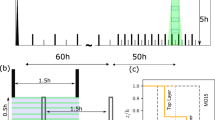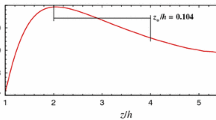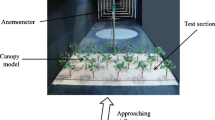Abstract
Available experimental results indicate that as the density of roughness elements over a horizontally homogeneous surface is varied, the roughness length, z 0, varies in a manner that exhibits a maximum at intermediate density values. In an attempt to explain this behaviour, the available analytical solutions for the wind profile inside dense homogeneous canopies were reviewed. The review indicated that the variation of z 0 with density depends on the interrelationship between the leaf density, a, and the mixing length, l. In view of this finding, a numerical model was devised based on a simple rule for constructing mixing-length profiles in the canopy. The rule states that the actual value of l is the maximum possible under the two constraints: l ⩽ l i and ¦dl/dz¦ ⩽ k, where k is the von Karman constant and the intrinsic mixing length, l i, is a function of the local internal structure of the canopy. The model which ensures a smooth transition from dense to thin canopy, was used to reproduce the observed maximum of z 0. The model is also capable of handling vertically non-homogeneous canopies.
Similar content being viewed by others
References
Chamberlain, A. C.: 1968, ‘Transport of Gases to and from Surfaces with Bluff and Wave-like Roughness Elements’, Quart. J. Roy. Meteorol. Soc. 94, 318–332.
Cionco, R. M.: 1965, ‘A Mathematical Model for Air Flow in a Vegetative Canopy’, J. Appl. Meteorol. 4, 517–522.
Cowan, I. R.: 1968, ‘Mass, Heat and Momentum Exchange Between Stands of Plants and Their Atmospheric Environment’, Quart. J. Roy. Meteorol. Soc. 94, 523–544.
Inoue, E.: 1963, ‘On the Turbulent Structure of Airflow within Crop Canopies’, J. Meteorol. Soc. Japan 41, 317–325.
Kawatani, T. and Meroney, R. N.: 1970, ‘Turbulence and Wind Speed Characteristics Within a Model Canopy Flow Field’, Agric. Meteorol. 7, 153–158.
Kondo, J.: 1971, ‘Relationship Between the Roughness Coefficient and other Aerodynamic Parameters’, J. Meteorol. Soc. Japan 49, 121–124.
Lettau, H.: 1969, ‘Note on Aerodynamic Roughness Parameter Estimation on the Basis of Roughness Element Description’, J. Appl. Meteorol. 8, 828–832.
Plate, E. J. and Quraishi, A. A.: 1965, ‘Modeling of Velocity Distributions Inside and Above Tall Crops’, J. Appl. Meteorol. 4, 400–408.
Robertson, J. M., Martin, J. D., and Burkhart, T. H.: 1968, ‘Turbulent Flow in Rough Pipes’, I & EC Fundamentals 7, 253–265.
Saito, T., Nagai, Y., Isobe, S., and Horibe, Y.: 1970, ‘An Investigation of Turbulence within a Crop Canopy’, J. Agric. Meteorol. Tokyo 25, 205–214. (Japanese with English summary).
Sayre, W. W. and Albertson M. L.: 1961, ‘Roughness Spacing in Rigid Open Channels’, Proc. ASCE 87(HY3), 121–150. 4
Seginer, I. and Rosenzweig, D.: 1972, ‘Flow Around Oriented Porous Obstructions II’, Technion Israel Inst. Tech., Dept. Agric. Eng. Publ. 160, 114 pp.
Sellers, W. D.: 1965, Physical Climatology, Univ. of Chicago Press, 272 pp.
Stanhill, G.: 1969, ‘A Simple Instrument for the Field Measurement of Turbulent Diffusion Flux’, J. Appl. Meteorol. 8, 509–513.
Thom, A. S.: 1971, ‘Momentum Absorption by Vegetation’, Quart. J. Roy Meteorol. Soc. 97, 414–428.
Author information
Authors and Affiliations
Rights and permissions
About this article
Cite this article
Seginer, I. Aerodynamic roughness of vegetated surfaces. Boundary-Layer Meteorol 5, 383–393 (1974). https://doi.org/10.1007/BF00123487
Revised:
Issue Date:
DOI: https://doi.org/10.1007/BF00123487




